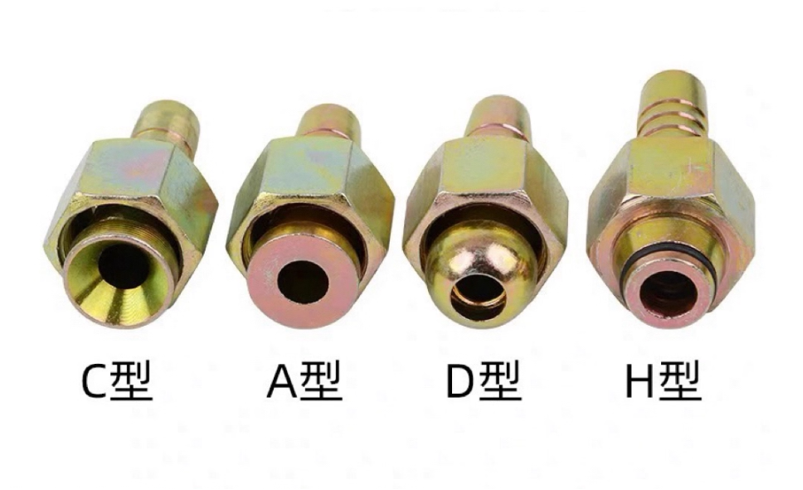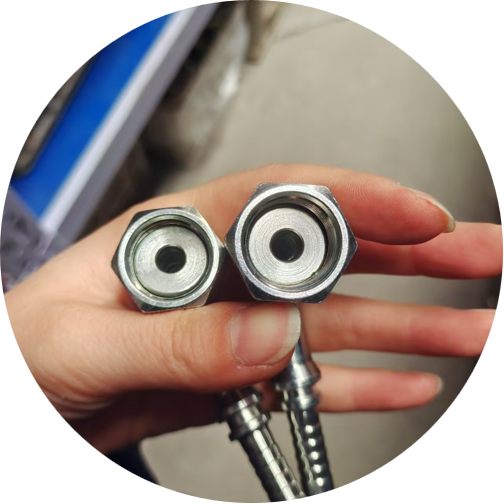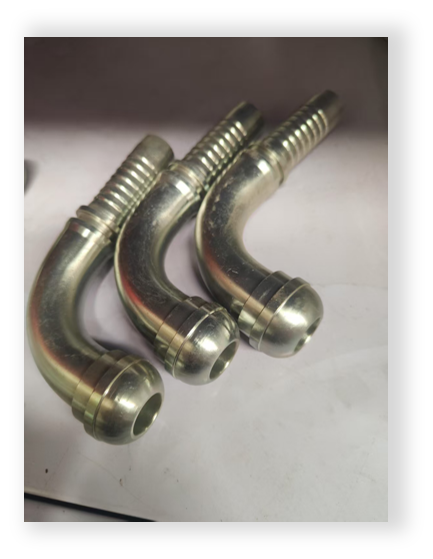In hydraulic systems, the hose-to-equipment interface faces high pressure, temperature swings, vibration, and corrosion. The connection must stay leak-free and mechanically strong. That’s why the crimp fitting—a permanent, machine-crimped connector—plays a critical role in building reliable hose assemblies.
This guide explains the two broad fitting categories (threaded “union” vs. crimped), then dives into six common crimp fitting types: A, C, D, H, F, and Q. You’ll learn how each seals, which thread families it uses, and where it fits best—plus a simple selection checklist and installation best practices.

What Is a Crimp Fitting?
A crimp fitting is permanently attached to a hydraulic hose using a crimping (or swaging/locking) machine. The ferrule/sleeve compresses onto the hose reinforcement to create a robust, leak-tight union between hose + fitting + seal. Compared with field-attachable/reusable fittings, crimped fittings offer:
Higher and more consistent pressure capability
Better vibration resistance and durability
Lower leak risk across the service life
Note: crimped fittings are typically non-reusable—do not attempt to re-crimp or re-use a removed fitting.
Crimp vs. Threaded “Union” Fittings
Threaded/union fittings join two rigid, threaded ends (e.g., tube-to-port).
Crimp fittings terminate a hose to a threaded or flanged connection.
Many systems use both: hose ends are crimped, then connect to pumps/valves/cylinders via a mating threaded or flanged port.
The Six Crimp Fitting Types (A / C / D / H / F / Q)
A-Type crimp fitting:Flat-Face O-Ring (End-Face Seal)

Seal: Flat face + O-ring on the end face
Threads: Typically metric
Strengths: Compact, excellent static sealing; good vibration tolerance because the O-ring absorbs micro-movement
Watchouts: End faces must be clean/undamaged; use compatible O-ring elastomer for oil and temperature
Best for: General-purpose and mobile hydraulics where a dependable O-ring end-face seal is preferred
C-Type crimp fitting: “Flare/Trumpet”

Seal: Metal-to-metal cone (hard seal); common cone angles 60° and 74°
Threads: UN/UNF (SAE) or BSP/BSW (inch), depending on standard
Strengths: High pressure capability; no soft seal to age
Watchouts: Requires precise cone contact; any nick or contamination on the cone seats can cause leaks
Best for: High-pressure, high-cleanliness systems where hard-cone sealing is desired
D-Type crimp fitting: Round-Profile

Seal: Also metal-to-metal cone; angles 60° or 74°
Threads: UN/UNF or BSP (varies)
Strengths: Simple, widely available, cost-effective
Watchouts: Same as C-Type—protect the cone seats and match the correct angle/thread
Best for: Cost-effective cone-seal applications across industrial and mobile equipment
H-Type crimp fitting: Dual Seal (24° Cone + Side O-Ring)

Seal: 24° metal cone plus a side O-ring (dual sealing)
Threads: Usually metric
Strengths: Two independent sealing lines enhance reliability under shock, vibration, and thermal cycling
Watchouts: Slightly higher component and assembly cost; must select the right O-ring material
Best for: Heavy-duty mobile machinery, forestry/ag equipment, and critical circuits needing redundant sealing
F-Type crimp fitting: Flange-Style Crimp Fitting
Seal/Retention: Flange head + bolts; sealing via O-ring, gasket, or machined flange face
Threads: Not thread-retained at the joint—bolted flange connection
Strengths: Ideal for large-bore, high-flow lines; easier service on big hoses; strong mechanical retention
Watchouts: Larger package size; requires flat, clean flange faces and correct bolt torque
Best for: Main pressure/return lines on construction and mining equipment, hydraulic power units, and any large-diameter hose runs
Q-Type crimp fitting: Hollow/Through-Passage Fitting

Seal: Application-specific (may use O-rings or cones)
Threads: Metric/UN/BSP depending on design
Strengths: Hollow body enables special functions—sensor ports, test points, through-flow, or routing
Watchouts: Typically custom; confirm flow path, pressure rating, and sealing stack with engineering
Best for: Specialty or custom assemblies where a hollow fitting provides instrumentation or dual-path functions
Quick Comparison
| Type | Primary Seal | Typical Threads | Pressure/Vibration | Typical Use Case |
| A | Flat face + O-ring | Metric | High / High | General/mobile hydraulics needing end-face O-ring seal |
| C | Cone (60°/74°) | UN/UNF, BSP | Very High / Medium | High-pressure, hard-seal preference |
| D | Cone (60°/74°) | UN/UNF, BSP | High / Medium | Common cone-seal applications |
| H | 24° cone + O-ring | Metric | Very High / Very High | Harsh duty, shock/vibration, redundancy |
| F | Flange (O-ring/gasket) | Bolted flange | Very High / High | Large-bore, high-flow main lines |
| Q | Application-specific | Metric/UN/BSP | Varies | Custom through-passage or instrumented lines |
How to Choose the Right Crimp Fitting (Checklist)
Match the hose: ID/OD, reinforcement (1-wire, 2-wire, spiral), bend radius, and rated pressure
Confirm the port standard: Metric, UN/UNF (SAE), BSP, NPT, or flange spec—avoid angle/thread mismatches (e.g., 60° vs 74°)
Pick the sealing strategy:
Static, compact → A-Type (flat face + O-ring)
High pressure, hard seal → C/D-Type (cone)
Shock/vibration → H-Type (dual seal)
Large bore/high flow → F-Type (flange)
Custom flow/sensing → Q-Type (hollow)
Consider environment: Temperature, oil type, corrosion exposure → choose proper plating and O-ring elastomer (NBR/FKM/EPDM)
Plan serviceability: Access for wrenching/bolting; flange swing clearance; test-port needs
Follow the crimp spec: Correct die set, crimp diameter, and visual inspection per your crimp chart
Installation Best Practices
Cut clean & square: Deburr and keep the hose interior spotless
Insert to full depth: Respect insertion marks; no under-insertion
Use the specified die: Crimp to the published diameter and verify with calipers
Inspect: No cracked ferrules, skewed crimps, or damaged seal faces
Pressure test: Especially for high-risk circuits or when qualifying a new assembly
Never re-use a crimped fitting
Applications We Support
Agricultural & forestry machinery: steering, propulsion, auxiliary circuits (H-Type/A-Type)
Construction & mining: main pressure/return, swing/boom lines (F-Type/H-Type)
Industrial hydraulics & HPUs: pump discharge, valve banks, manifolds (A/C/D-Type)
Custom systems: test ports, measurement, dual-path circuits (Q-Type)
Looking for OEM branding, custom angles, or private-label packaging? Email sales01@blince.com.
Frequently Asked Questions (FAQ)
Q1: Can I re-use a crimp fitting?
A: No. Crimp fittings are permanent. Re-use risks leaks and failure.
Q2: How do I tell 60° from 74° cone seats?
A: Match the angle to the port/female seat per standard and verify with gauges. Never force-mate different angles.
Q3: When should I choose dual seal (H-Type)?
A: In shock, vibration, or safety-critical circuits where redundant sealing (24° cone + O-ring) boosts reliability.
Q4: Why choose a flange (F-Type)?
A: For large-diameter hoses and high flow; bolted flanges provide strong retention and easier servicing.
Q5: Which O-ring should I use?
A: Base elastomer on fluid and temperature: NBR (mineral oil), FKM (higher temp/chemicals), EPDM (water-glycol). Always confirm compatibility.
Q6: What causes most leaks?
A: Damaged cone faces, wrong angle/thread, dirty mating surfaces, wrong crimp diameter, or aged/damaged O-rings.





























